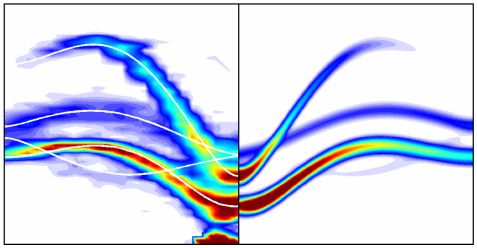MLZ is a cooperation between:
 > Technische Universität München
> Technische Universität München > Helmholtz-Zentrum Hereon
> Helmholtz-Zentrum Hereon
 > Forschungszentrum Jülich
> Forschungszentrum Jülich
MLZ is a member of:
 > LENS
> LENS > ERF-AISBL
> ERF-AISBL
MLZ on social media:

MLZ (eng)
Lichtenbergstr.1
85748 Garching
01.08.2016
Existence of Weak Electromagnons Verified with Neutrons
Researchers at the Jülich Centre for Neutron Science (JCNS) together with German and international partners have for the first time unequivocally detected weak electromagnons by means of neutron scattering. Their studies of hübnerite single crystals (chemical formula: MnWO4) have established a further building block towards a better understanding of the complex phenomenon that is multiferroicity.
Multiferroic materials are magnetic and electric at the same time; both properties mutually influence each other: magnetic forces are able to displace atoms in multiferroic materials by a fraction from their original position, thus electrically polarizing the crystal. In turn, the magnetization can be changed by applying electric fields. This makes the material class an interesting candidate for technical applications, such as new data storage systems for information technology. For this purpose, the bits would be written by means of applying a voltage instead of an electric field. In comparison with current methods, this new approach could save electricity and accelerate storage processes.
In order to customize the design of multiferroic materials in such a way that they can be used at room temperature, it is important to understand in detail how the electromagnetic coupling comes about and in which materials it is particularly strong. The occurrence of electromagnons is viewed as an indication of multiferroic materials with a particularly strong coupling. Electromagnons are elementary excitations that exhibit both electric and magnetic dipole moments. It is only in the last few years that it has been possible to observe them in experiments using infrared spectroscopy. However, this method is not powerful enough for weak electromagnons. The research team headed by Dr. Yinguo Xiao from JCNS has now successfully achieved the first clear demonstration of low-energy electromagnons (0.07 meV and 0.45 meV). For the studies, the researchers used the cold triple-axis spectrometer PANDA, which is operated at Forschungszentrum Jülich’s outstation at Heinz Maier-Leibnitz Zentrum (MLZ) in Garching near Munich.
Original publication:
Y. Xiao et al.; Spin-wave and electromagnon dispersions in multiferroic MnWO4 as observed by neutron spectroscopy: Isotropic Heisenberg exchange versus anisotropic Dzyaloshinskii-Moriya interaction; PHYSICAL REVIEW B 00, 004400 (2016), DOI: 10.1103/PhysRevB.93.214428
MLZ is a cooperation between:
 > Technische Universität München
> Technische Universität München > Helmholtz-Zentrum Hereon
> Helmholtz-Zentrum Hereon
 > Forschungszentrum Jülich
> Forschungszentrum Jülich
MLZ is a member of:
 > LENS
> LENS > ERF-AISBL
> ERF-AISBL
MLZ on social media:



